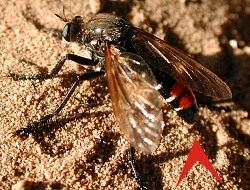
 Introduction
Introduction
 History
History
 Morphology
Morphology
 Terminology
Terminology
 Phylogeny
Phylogeny
 Distribution
Distribution
 Ecology
Ecology
 Biology
Biology
 Immatures
Immatures
 Foraging
Foraging
 Prey
Prey
 Courtship
Courtship
 Oviposition
Oviposition
 Mimicry
Mimicry
 Collecting
Collecting
 Determination
Determination
 Photography
Photography
 References
References
|
|
LONDT (1994): "Once these categories had been established, it became apparent that apart from feeding, oviposition was also well-supported by this classification. Although oviposition has not been observed in the vast majority of genera, ovipostion strategies can be confidently inferred from oviposition morphology as suggested by Melin (1923) in his pioneering work on Swedish asilids. A generic survey of ovipositor structure suggests that there are three main oviposition strategies within the family: i. Random egg-dropping; ii. Oviposition in sand or soil; iii. Oviposition on or in vegetation. Brief elaboration will provide the morphological criteria upon which these oviposition strategies are based.
Random egg-dropping: The female abdomen is circular in cross-section and the genital structures show no special adaptations for oviposition. The abdomen is usually rounded posteriorly, the terminal segments are not usually elongate, the cerci and subgenital plate are simple, and the setae exhibit no unusual adaptions.
|
Oviposition in sand or soil: The female abdomen is circular in cross-section or dorsoventrally compresed (only occasionally somewhat laterally compressed). The postabdomen is adapted, in one or more ways, for depositing eggs into soil or under loose sand. These adaptations may take the form of elongated terminal segments, pointed and/or upturned cerci and/or subgenital plate, and/or the presence of stout spines or setae.
|
 |
An indication of the ovipostion strategies usually practised within each ecological category proposed has been given in Fig. 2 [see Ecological Classification]. Species which normally hunt from the ground surface always oviposit in sand or soil. Soecies inhabiting grass or bushes either drop their eggs at random to the ground, fly to the ground surface and deposit eggs there, or oviposit on the plants themselves. Tree frequenting species either drop their eggs to the ground or oviposit on or in the tree; as yet no examples of ground visiting species are known.
A further clue to oviposition behaviour may be provided by egg shape. Spherical eggs tyify random egg-droppers while elongate-ovoid eggs are characteristic of species ovipositing in vegetation. Eggs of species which oviposit in soil are intermediate between these two extremes."
|



|